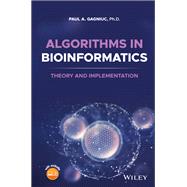Explore a comprehensive and insightful treatment of the practical application of bioinformatic algorithms in a variety of fields
Algorithms in Bioinformatics: Theory and Implementation delivers a fulsome treatment of some of the main algorithms used to explain biological functions and relationships. It introduces readers to the art of algorithms in a practical manner which is linked with biological theory and interpretation. The book covers many key areas of bioinformatics, including global and local sequence alignment, forced alignment, detection of motifs, Sequence logos, Markov chains or information entropy. Other novel approaches are also described, such as Self-Sequence alignment, Objective Digital Stains (ODSs) or Spectral Forecast and the Discrete Probability Detector (DPD) algorithm.
The text incorporates graphical illustrations to highlight and emphasize the technical details of computational algorithms found within, to further the reader’s understanding and retention of the material. Throughout, the book is written in an accessible and practical manner, showing how algorithms can be implemented and used in JavaScript on Internet Browsers. The author has included more than 120 open-source implementations of the material, as well as 33 ready-to-use presentations. The book contains original material that has been class-tested by the author and numerous cases are examined in a biological and medical context. Readers will also benefit from the inclusion of:
- A thorough introduction to biological evolution, including the emergence of life, classifications and some known theories and molecular mechanisms
- A detailed presentation of new methods, such as Self-sequence alignment, Objective Digital Stains and Spectral Forecast
- A treatment of sequence alignment, including local sequence alignment, global sequence alignment and forced sequence alignment with full implementations
- Discussions of position-specific weight matrices, including the count, weight, relative frequencies, and log-likelihoods matrices
- A detailed presentation of the methods related to Markov Chains as well as a description of their implementation in Bioinformatics and adjacent fields
- An examination of information and entropy, including sequence logos and explanations related to their meaning
- An exploration of the current state of bioinformatics, including what is known and what issues are usually avoided in the field
- A chapter on philosophical transactions that allows the reader a broader view of the prediction process
- Native computer implementations in the context of the field of Bioinformatics
- Extensive worked examples with detailed case studies that point out the meaning of different results
Perfect for professionals and researchers in biology, medicine, engineering, and information technology, as well as upper level undergraduate students in these fields, Algorithms in Bioinformatics: Theory and Implementation will also earn a place in the libraries of software engineers who wish to understand how to implement bioinformatic algorithms in their products.









